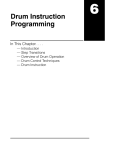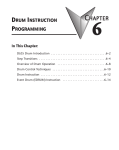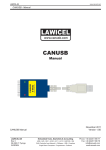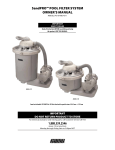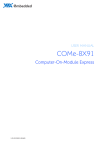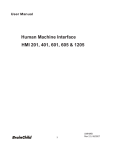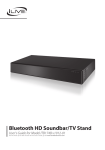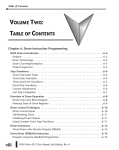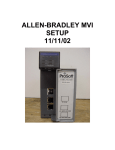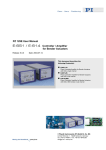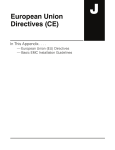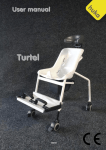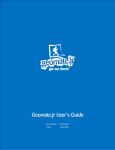Download Chapter 6 - AutomationDirect
Transcript
Drum Instruction Programming In This Chapter. . . . — Introduction — Step Transitions — Overview of Drum Operation — Drum Control Techniques — Drum Instructions 16 6--2 Drum Instruction Programming Drum Instruction Programming Introduction Purpose Drum Terminology The four drum instructions available in the DL350 CPU electronically simulate an electro-mechanical drum sequencer. The instructions offer slight variations on the basic principle. Drum instructions are best suited for repetitive processes consisting of a finite number of steps. They can do the work of many rungs of ladder logic with simplicity. Therefore, drums can save a programming and debugging time. We introduce some terminology associated with drum instructions by describing the original electro-mechanical drum pictured below. The mechanical drum generally has pegs on its curved surface. The pegs are populated in a particular pattern, representing a set of desired actions for machine control. A motor or solenoid rotates the drum a precise amount at specific times. During rotation, stationary wipers sense the presence of pegs (present = on, absent = off). This interaction makes or breaks electrical contact with the wipers, creating electrical outputs from the drum. The outputs are wired to devices on a machine for On/Off control. Drums usually have a finite number of positions within one rotation, called steps. Each step represents some process step. At powerup, the drum resets to a particular step. The drum rotates from one step to the next based on a timer, or on some external event. During special conditions, a machine operator can manually increment the drum step using a jog control on the drum’s drive mechanism. The contact closure of each wiper generates a unique on/off pattern called a sequence, designed for controlling a specific machine. Because the drum is circular, it automatically repeats the sequence once per rotation. Applications vary greatly, and a particular drum may rotate once per second, or as slowly as once per week. Pegs Wipers Drum Outputs Electronic drums provide the benefits of mechanical drums and more. For example, they have a preset feature that is impossible for mechanical drums: The preset function lets you move from the present step directly to any other step on command! DL350 User Manual, 2nd Edition 6--3 Drum Instruction Programming For editing purposes, the electronic drum is presented in chart form in DirectSOFT and in this manual. Imagine slicing the surface of a hollow drum cylinder between two rows of pegs, then pressing it flat. Now you can view the drum as a chart as shown below. Each row represents a step, numbered 1 through 16. Each column represents an output, numbered 0 through 15 (to match word bit numbering). The solid circles in the chart represent pegs (On state) in the mechanical drum, and the open circles are empty peg sites (Off state). OUTPUTS STEP 15 14 13 12 11 10 9 8 7 6 5 4 3 2 1 0 1 f F f F f f F f f f F f f F f f 2 f F f F F f F f f f f F f f F f 3 f F F F F f F F f f f f f f f f 4 F F f F F f F f F f f f f f f F 5 f f f F f f F f F f F f F f f F 6 f f f F f f F f F f F f F F f F 7 F f f F f f F F F F f F F F f F 8 F f F f f F f F F f f f F f f F 9 f f f f f f f F F f f f F f f f 10 f f f f f f f F F F f f f f f f 11 F f f f F f f f f F f f f f F f 12 f F f f F F f f F f F F f F F f 13 f f F f f f f f f f f F F f F f 14 f f f f f f f F f f f F F f F F 15 F f f f f F f F f F f F f f F F 16 f f F f f f f F f F f F F f f F Output Sequences The mechanical drum sequencer derives its name from sequences of control changes on its electrical outputs. The following figure shows the sequence of On/Off controls generated by the drum pattern above. Compare the two, and you will find they are equivalent! If you can see their equivalence, you are on your way to understanding drum instruction operation. Step Output 0 1 2 3 4 5 6 7 8 9 10 11 12 13 14 15 1 2 3 4 5 6 7 8 9 10 11 12 13 14 15 1 0 1 0 1 0 1 0 1 0 1 0 1 0 1 0 1 0 1 0 1 0 1 0 1 0 1 0 1 0 1 0 DL350 User Manual, 2nd Edition 16 Drum Instruction Programming Drum Chart Representation 6--4 Drum Instruction Programming Drum Instruction Programming Step Transitions Drum Instruction Types Timer-Only Transitions There are four types of Drum instructions in the DL350 CPU: S Timed Drum with Discrete Outputs (DRUM) S Time and Event Drum with Discrete Outputs (EDRUM) S Masked Event Drum with Discrete Outputs (MDRUMD) S Masked Event Drum with Word Output (MDRUMW) The four drum instructions all include time-based step transitions, and three include event-based transitions as well. Other options include outputs defined as a single word or as individual bits, and an output mask (individual output disable/enable). Each drum has 16 steps, and each step has 16 outputs. Refer to the figure below. Each output can be either an X, Y, or C coil, offering programming flexibility. We assign Step 1 an arbitrary unique output pattern (f= Off, F= On) as shown. When programming a drum instruction, you also determine both the output assignment and the On/Off state (pattern) at that time. All steps use the same output assignment, but each step may have its own unique output pattern. Drums move from step to step based on time and/or an external event (input). All four drum types offer timer step transitions, and three types also offer events. The figure below shows how timer-only transitions work. Step 1 Outputs: F f f f F f F f f f f F F f f f Outputs: f f f F f f f f F F f F f f F F Increment count timer No Has counts per step expired? Yes Step 2 Use next transition criteria The drum stays in each step for a specific duration (user-programmable). The timebase of the timer is programmable, from 0.01 seconds to 99.99 seconds. This establishes the resolution, or the duration of each “tick of the clock”. Each step uses the same timebase, but has its own unique counts per step, which you program. The drum spends a specific amount of time in each step, given by the formula: Time in step = 0.01 seconds X Timebase x Counts per step DL350 User Manual, 2nd Edition Drum Instruction Programming 6--5 NOTE: When first choosing the timebase resolution, a good rule is to make it approximately 1/10 the duration of the shortest step in your drum. You will be able to optimize the duration of that step in 10% increments. Other steps with longer durations allow optimizing by even smaller increments (percentage-wise). Also, note the drum instruction executes once per CPU scan. Therefore, it is pointless to specify a drum timebase faster than the CPU scan time. Timer and Event Transitions Time and Event Drums move from step to step based on time and/or external events. The figure below shows how step transitions work for these drums. Step 1 No Outputs: F f f f F f F f f f f F F f f f Is Step event true? Yes Increment count timer No Has step counts expired? Yes Step 2 Outputs: f f f F f f f f F F f F f f F F Use next transition criteria When the drum enters Step 1, the output pattern shown is set. It begins polling the external input programmed for that step. You can define event inputs as X, Y, or C discrete point types. Suppose we select X0 for the Step 1 event input. If X0 is off, then the drum remains in Step 1. When X0 is On, the event criteria is met and the timer increments. The timer increments as long as the event remains true. When the counts for Step 1 have expired, the drum moves to Step 2. The outputs change immediately to match the new pattern for Step 2. DL350 User Manual, 2nd Edition Drum Instruction Programming For example, if you program a 5 second time base and 12 counts for Step 1, the drum will spend 60 seconds in Step 1. The maximum time for any step is given by the formula: Max Time per step = 0.01 seconds X 9999 X 9999 = 999,800 seconds = 277.7 hours = 11.6 days Drum Instruction Programming 6--6 Drum Instruction Programming Event-Only Transitions Time and Event drums do not have to possess both the event and the timer criteria programmed for each step. You have the option of programming one of the two, and even mixing transition types among all the steps of the drum. For example, you might want Step 1 to transition on an event, Step 2 to transition on time only, and Step 3 to transition on both time and an event. Furthermore, you may elect to use only part of the 16 steps, and only part of the 16 outputs. Step 1 No Outputs: F f f f F f F f f f f F F f f f Outputs: f f f F f f f f F F f F f f F F Is Step event true? Yes Step 2 Use next transition criteria Counter Assignments Each drum instruction uses the resources of four counters in the CPU. When programming the drum instruction, you select the first counter number. The drum also uses the next three counters automatically. The counter bit associated with the first counter turns on when the drum has completed its cycle, going off when the drum is reset. These counter values and counter bit precisely indicate the progress of the drum instruction, and can be monitored by your ladder program. Suppose you program a timer drum to have 8 steps, and we select CT10 for the counter number (remember, counter numbering is in octal). Counter usage is shown to the right. The right column holds typical values, interpreted below. Counter Assignments CT10 Counts in step V1010 1528 CT11 Timer Value V1011 0200 CT12 Preset Step V1012 0001 CT13 Current Step V1013 0004 CT10 shows you are at the 1528th count in the current step, which is step 4 (shown in CT13). If we have programmed step 4 to have 3000 counts, the step is over half completed. CT11 is the count timer, shown in units of 0.01 seconds. So, each least-significant-digit change represents 0.01 seconds. The value of 200 means you have been in the current count (1528) for 2 seconds (0.01 x 100). Finally, CT12 holds the preset step value which was programmed into the drum instruction. When the drum’s Reset input is active, it presets to step 1 in this case. The value of CT12 does not change without a program edit. Counter bit CT10 turns on when the drum cycle is complete, and turns off when the drum is reset. DL350 User Manual, 2nd Edition Drum Instruction Programming The last step in a drum sequence may be any step number, since partial drums are valid. Refer to the following figure. When the transition conditions of the last step are satisfied, the drum sets the counter bit corresponding to the counter named in the drum instruction box (such as CT0). Then it moves to a final “drum complete” state. The drum outputs remain in the pattern defined for the last step (including any output mask logic). Having finished a drum cycle, the Start and Jog inputs have no effect at this point. The drum leaves the “drum complete” state when the Reset input becomes active (or on a program-to-run mode transition). It resets the drum complete bit (such as CT0), and then goes directly to the appropriate step number defined as the preset step. Last step No Outputs: Are transition conditions met? F F F f f f F f f F f F F F f F (Timer and/or Event criteria) Yes Set CT0 = 1 Complete No Set Drum Complete bit Outputs: F F F f f f F f f F f F F F f F Reset Input Active? Yes Reset CT0 = 0 Reset Drum Complete bit Go to Preset Step DL350 User Manual, 2nd Edition Drum Instruction Programming Last Step Completion 6--7 6--8 Drum Instruction Programming Drum Instruction Programming Overview of Drum Operation Drum Instruction Block Diagram The drum instruction utilizes various inputs and outputs in addition to the drum pattern itself. Refer to the figure below. Inputs DRUM INSTRUCTION Block Diagram Outputs Start Realtime Inputs (from ladder) Jog * Reset Drum Preset Step Counts/Step Timebase Programming Selections Step Control Step Pointer Events * f f f F f f f f f f f F F F F F F f f f F F f F f f f F f f f f f f f f F f F f F f F F F F f F Outputs Output Mask * Final Drum Outputs Counter # Pattern Output Mask * Counter Assignments * Asterisked inputs are applicable only to particular drum instructions. CT0 Counts in step V1000 xxxx CT1 Timer Value V1001 xxxx CT2 Preset Step V1002 xxxx CT3 Current Step V1003 xxxx The drum instruction accepts several inputs for step control, the main control of the drum. The inputs and their functions are: S S S S Start -- The Start input is effective only when Reset is off. When Start is on, the drum timer runs if it is in a timed transition, and the drum looks for the input event during event transitions. When Start is off, the drum freezes in its current state (Reset must remain off), and the drum outputs maintain their current on/off pattern. Jog -- The jog input is only effective when Reset is off (Start may be either on or off). The jog input increments the drum to the next step on each off-to-on transition. Note that only the basic timer drum does not have a jog input. Reset -- The Reset input has priority over the Start input. When Reset is on, the drum moves to its preset step. When Reset is off, then the Start input operates normally. Preset Step -- A step number from 1 to 16 that you define (typically is step 1). The drum moves to this step whenever Reset is on, and whenever the CPU first enters run mode. DL350 User Manual, 2nd Edition Drum Instruction Programming S S Counts/Step -- The number of timer counts the drum spends in each step. Each step has its own counts parameter. However, programming the counts/step is optional on Timer/Event drums. Timer Value -- the current value of the counts/step timer. Counter # -- The counter number specifies the first of four consecutive counters which the drum uses for step control. You can monitor these to determine the drum’s progress through its control cycle. Events -- Either an X, Y, C, S, C, CT, or SP type discrete point serves as step transition inputs. Each step has its own event. However, programming the event is optional on Timer/Event drums. WARNING: The outputs of a drum are enabled any time the CPU is in Run Mode. The Start Input does not have to be on, and the Reset input does not disable the outputs. Upon entering Run Mode, drum outputs automatically turn on or off according to the pattern of the preset step. This includes any effect of the output mask when applicable. Powerup State of Drum Registers The choice of the starting step on powerup and program-to-run mode transitions are important to consider for your application. Please refer to the following chart. If the counter memory is configured as non-retentive, the drum is initialized the same way on every powerup or program-to-run mode transition. However, if the counter memory is configured to be retentive, the drum will stay in its previous state. Counter NumNum ber Function Initialization on Powerup Non-Retentive Case Retentive Case CT(n) Current Step Count Initialize = 0 Use Previous (no change) CT(n + 1) Counter Timer Value Initialize = 0 Use Previous (no change) CT(n + 2) Preset Step Initialize = Preset Step # Use Previous (no change) CT(n + 3) Current Step # Initialize = Preset Step # Use Previous (no change) Applications with relatively fast drum cycle times typically will need to be reset on powerup, using the non-retentive option. Applications with relatively long drum cycle times may need to resume at the previous point where operations stopped, using the retentive case. The default option is the retentive case. This means that if you initialize scratchpad V-memory, the memory will be retentive. DL350 User Manual, 2nd Edition Drum Instruction Programming S S 6--9 6--10 Drum Instruction Programming Drum Instruction Programming Drum Control Techniques Drum Control Inputs Now we are ready to put together the concepts on the previous pages and demonstrate general control of the drum instruction box. The drawing to the right shows a simplified generic drum instruction. Inputs from ladder logic control the Start, Jog, and Reset Inputs. The first counter bit of the drum (CT0, for example) indicates the drum cycle is done. X0 Start X1 Jog X2 Reset Outputs Setup Info. Steps Mask f f f F f f f f f f f F F F F F F f f f F F f F f f f F f f f f f f f f F f F f F f F F F F f F The timing diagram below shows an arbitrary timer drum input sequence and how the drum responds. As the CPU enters run mode it initializes the step number to the preset step number (typically is Step 1). When the Start input goes high the drum begins running, looking for an event and/or running the count timer (depending on the drum type and setup). After the drum enters Step 2, Reset turns On while Start is still On. Since Reset has priority over Start, the drum goes to the preset step (Step 1). Note the drum is held in the preset step during Reset, and that step does not run (respond to events or run the timer) until Reset turns off. After the drum has entered step 3, the Start input goes off momentarily, halting the drum’s timer until Start turns on again. Start drum Inputs Start 1 0 Jog 1 0 Reset 1 0 Reset drum Hold drum Resume drum Drum Reset Complete drum Drum Status 1 Step # Drum Complete (CT0) 1 Outputs (x 16) 1 0 1 2 1 1 2 3 3 4 ... 15 16 16 16 1 1 0 When the drum completes the last step (Step 16 in this example), the Drum Complete bit (CT0) turns on, and the step number remains at 16. When the Reset input turns on, it turns off the Drum Complete bit (CT0), and forces the drum to enter the preset step. NOTE: The timing diagram shows all steps using equal time durations. Step times can vary greatly, depending on the counts/step programmed. DL350 User Manual, 2nd Edition 6--11 Drum Instruction Programming Jog drum Inputs Start 1 0 Jog 1 0 Reset 1 0 Reset drum Jog drum Jog drum Drum Complete Drum Status 1 Step # Self-Resetting Drum Initializing Drum Outputs Drum Complete (CT0) 1 Outputs (x 16) 1 0 2 3 3 3 4 5 6,7 8 ... 14 15 16 16 16 1 0 Applications often require drums that automatically start over once they complete a cycle. This is easily accomplished, using the drum complete bit. In the figure to the right, the drum instruction setup is for CT0, so we logically OR the drum complete bit (CT0) with the Reset input. When the last step is done, the drum turns on CT0 which resets itself to the preset step, also resetting CT0. Contact X1 still works as a manual reset. X0 X1 CT0 Start Reset Outputs Setup Info. Steps Mask f f f F f f f f f f f F F F F F F f f f F F f F f f f F f f f f f f f f F f F f F f F F F F f F The outputs of a drum are enabled any time the CPU is in run mode. On program-to-run mode transitions, the drum goes to the preset step, and the outputs energize according to the pattern of that step. If your application requires all outputs to be off at powerup, there are two approaches: S Make the preset step in the drum a “reset step”, with all outputs off. S Or, use a drum with an output mask. Initialize the mask to “0000” on the first scan using contact SP0, and LD K000 and OUT Vxxx instructions, where Vxxxx is the location of the mask register. DL350 User Manual, 2nd Edition Drum Instruction Programming In the figure below, we focus on how the Jog input works on event drums. To the left of the diagram, note the off-to-on transitions of the Jog input increments the step. Start may be either on or off (however, Reset must be off). Two jogs takes the drum to step three. Next, the Start input turns on, and the drum begins running normally. During step 6 another Jog input signal occurs. This increments the drum to step 7, setting the timer to 0. The drum begins running immediately in step 7, because Start is already on. The drum advances to step 8 normally. As the drum enters step 14, the Start input turns off. Two more Jog signals moves the drum to step 16. However, note that a third Jog signal is required to move the drum through step 16 to “drum complete”. Finally, a Reset input signal arrives which forces the drum into the preset step and turns off the drum complete bit. 6--12 Drum Instruction Programming Drum Instruction Programming Drum Instructions Timed Drum with Discrete Outputs (DRUM) The DL350 drum instructions may be programmed using DirectSOFT or for the EDRUM instruction only you can use a handheld programmer (firmware version v1.8 or later. This section covers entry using DirectSOFT for all instructions plus the handheld mnemonics for the EDRUM instruction. The Timed Drum with Discrete Outputs is the most basic of the DL350’s drum instructions. It operates according to the principles covered on the previous pages. Below is the instruction in chart form as displayed by DirectSOFT. Step Preset Timebase Counter Number Discrete Output Assignment Start Control Inputs Reset Step Number Counts per Step Output Pattern f= Off, F= On The Timed Drum features 16 steps and 16 outputs. Step transitions occur only on a timed basis, specified in counts per step. Unused steps must be programmed with “counts per step” = 0 (this is the default entry). The discrete output points may be individually assigned as X, Y, or C types, or may be left unused. The output pattern may be edited graphically with DirectSOFT. Whenever the Start input is energized, the drum’s timer is enabled. It stops when the last step is complete, or when the Reset input is energized. The drum enters the preset step chosen upon a CPU program-to-run mode transition, and whenever the Reset input is energized. Drum Parameters Field Data Types Ranges Counter Number aaa -- 0 -- 177 Preset Step bb K 1 -- 16 Timer base cccc K 0 -- 99.99 seconds Counts per step dddd K 0 -- 9999 Discrete Outputs Fffff X, Y, C see page 3--29 DL350 User Manual, 2nd Edition Drum Instruction Programming 6--13 Counter Number Ranges of (n) Function Counter Bit Function CT(n) 0 -- 124 Counts in step CTn = Drum Complete CT( n+1) 1 -- 125 Timer value CT(n+1) = (not used) CT( n+2) 2 --126 Preset Step CT(n+2) = (not used) CT( n+3) 3 --127 Current Step CT(n+1) = (not used) The following ladder program shows the DRUM instruction in a typical ladder program, as shown by DirectSOFT. Steps 1 through 10 are used, and twelve of the sixteen output points are used. The preset step is step 1. The timebase runs at 100 mS per count. Therefore, the duration of step 1 is (25 x 0.1) = 2.5 seconds. In the last rung, the Drum Complete bit (CT0) turns on output Y0 upon completion of the last step (step 10). A drum reset also resets CT0. DL350 User Manual, 2nd Edition Drum Instruction Programming Drum instructions use four counters in the CPU. The ladder program can read the counter values for the drum’s status. The ladder program may write a new preset step number to CT(n+2) at any time. However, the other counters are for monitoring purposes only. Drum Instruction Programming 6--14 Drum Instruction Programming Event Drum with Discrete Outputs (EDRUM) The Event Drum with Discrete Outputs has all the features of the Timed Drum, plus event-based step transitions. It operates according to the general principles of drum operation covered in the beginning of this section. Below is the instruction in chart form as displayed by DirectSOFT. Counter Number Step Preset EDRUM1 Timebase Discrete Output Assignment Start Control Inputs Jog Reset Step Number Counts per Step Event per step Output Pattern f= Off, F= On The Event Drum with Discrete Outputs features 16 steps and 16 outputs. Step transitions occur on timed and/or event basis. The jog input also advances the step on each off-to-on transition. Time is specified in counts per step, and events are specified as discrete contacts. Unused steps must be programmed with “counts per step” = 0, and event = “0000”. The discrete output points may be individually assigned. The output pattern may be edited graphically with DirectSOFT. Whenever the Start input is energized, the drum’s timer is enabled. As long as the event is true for the current step, the timer runs during that step. When the step count equals the counts per step, the drum transitions to the next step. This process stops when the last step is complete, or when the Reset input is energized. The drum enters the preset step chosen upon a CPU program-to-run mode transition, and whenever the Reset input is energized. Drum Parameters Field Data Types Ranges Counter Number aaa -- 0 -- 177 Preset Step bb K 1 -- 16 Timer base cccc K 0 -- 99.99 seconds Counts per step dddd K 0 -- 9999 Event eeee X, Y, C, S, T, ST Discrete Outputs Fffff X, Y, C , DL350 User Manual, 2nd Edition Drum Instruction Programming 6--15 Counter Number Ranges of (n) Function Counter Bit Function CT(n) 0 -- 124 Counts in step CTn = Drum Complete CT( n+1) 1 -- 125 Timer value CT(n+1) = (not used) CT( n+2) 2 --126 Preset Step CT(n+2) = (not used) CT( n+3) 3 --127 Current Step CT(n+1) = (not used) The following ladder program shows the EDRUM instruction in a typical ladder program, as shown by DirectSOFT. Steps 1 through 11 are used, and all sixteen output points are used. The preset step is step 1. The timebase runs at 100 mS per count. Therefore, the duration of step 1 is (5 x 0.1) = 0.5 seconds. Note that step 1 is time-based only (event = “K0000”). And, the output pattern for step 1 programs all outputs off, which is a typically desirable powerup condition. In the last rung, the Drum Complete bit (CT4) turns on output Y0 upon completion of the last step (step 10). A drum reset also resets CT4. DL350 User Manual, 2nd Edition Drum Instruction Programming Drum instructions use four counters in the CPU. The ladder program can read the counter values for the drum’s status. The ladder program may write a new preset step number to CT(n+2) at any time. However, the other counters are for monitoring purposes only. Drum Instruction Programming 6--16 Drum Instruction Programming The handheld programmer can also enter or edit drum instructions. The diagram below lists the keystrokes for entering the drum example on the previous page. NOTE: Drum editing requires Handheld Programmer firmware version 1.8 or later. Handheld Programmer Keystrokes Start $ Jog $ Reset $ Drum Inst. SHFT A STR B STR C STR E 4 D NOTE: You may use the NXT and PREV keys to skip past entries for unused outputs or steps. ENT 0 ENT 1 ENT 2 R ORN 3 U Preset Step ( DEF K0001) NEXT Time Base ( DEF K0000 ) G ( DEF 0000 ) SHFT C ( DEF 0000 ) SHFT C ( DEF 0000 ) SHFT Y MLS B ( DEF 0000 ) SHFT Y MLS E ( DEF 0000 ) SHFT Y MLS F ( DEF 0000 ) SHFT Y MLS G ( DEF 0000 ) SHFT C E ( DEF 0000 ) SHFT C ( DEF 0000 ) SHFT Y MLS A ( DEF 0000 ) SHFT Y MLS C ( DEF 0000 ) SHFT C B ( DEF 0000 ) SHFT C ( DEF 0000 ) SHFT Y MLS G ( DEF 0000 ) SHFT Y MLS H ( DEF 0000 ) SHFT C D 16 ( DEF 0000 ) SHFT Y MLS 1 6 Outputs E 4 2 2 2 2 2 2 2 M ORST ISG A 0 ENT Handheld Programmer Keystrokes cont’d NEXT H B C D B 7 1 1 4 5 6 4 2 0 2 1 3 6 7 3 1 NEXT A 0 NEXT 1 ( DEF K0000 ) F ( DEF K0000 ) C NEXT ( DEF K0000 ) NEXT ( DEF K0000 ) NEXT ( DEF K0000 ) NEXT ( DEF K0000 ) NEXT ( DEF K0000 ) NEXT Counts/ Step ( DEF K0000 ) B E B J B I 5 2 1 4 1 9 1 8 ( DEF K0000 ) B ( DEF K0000 ) E NEXT ( DEF K0000 ) NEXT NEXT ( DEF K0000 ) NEXT NEXT ( DEF K0000 ) NEXT NEXT ( DEF K0000 ) NEXT ( DEF K0000 ) NEXT 16 ( DEF K0000 ) NEXT NEXT NEXT E A E 4 0 4 NEXT NEXT 1 4 NEXT A F F I C C G C A 0 5 5 8 2 2 6 2 0 (Continued on next page) DL350 User Manual, 2nd Edition NEXT A NEXT 0 NEXT A D A E A A 0 3 0 4 0 0 NEXT NEXT NEXT NEXT A 0 NEXT NEXT skip over unused steps Drum Instruction Programming Handheld Programmer Keystrokes cont’d ( DEF 0000 ) ( DEF 0000 ) ( DEF 0000 ) ( DEF 0000 ) ( DEF 0000 ) ( DEF 0000 ) ( DEF 0000 ) ( DEF 0000 ) SHFT SHFT SHFT SHFT SHFT SHFT Events ( DEF 0000 ) ( DEF 0000 ) ( DEF 0000 ) 16 skip over unused event NEXT SHFT SHFT SHFT SHFT ( DEF 0000 ) NEXT ( DEF 0000 ) NEXT ( DEF 0000 ) NEXT ( DEF 0000 ) NEXT ( DEF 0000 ) NEXT Handheld Programmer Keystrokes cont’d Y MLS E X SET B X SET C C A C 2 2 B X SET A X SET F X SET D Y MLS H C C 2 4 1 2 0 1 0 5 3 7 2 1 NEXT ( DEF K0000 ) NEXT ( DEF K0000 ) NEXT ( DEF K0000 ) NEXT NEXT NEXT NEXT Output Pattern NEXT 0 NEXT Last rung C E ( DEF K0000 ) J ( DEF K0000 ) E ( DEF K0000 ) J ( DEF K0000 ) 16 J F ( DEF K0000 ) step 1 pattern = 0000 NEXT ( DEF K0000 ) ( DEF K0000 ) NEXT A ( DEF K0000 ) D F I 9 2 4 5 9 4 9 3 5 8 I I E B D E E I I E ( DEF K0000 ) NEXT ( DEF K0000 ) NEXT ( DEF K0000 ) NEXT ( DEF K0000 ) NEXT ( DEF K0000 ) NEXT $ GY CNT A Y MLS A STR SHFT 8 8 4 1 3 4 4 8 8 4 B J H G E I F 1 9 7 6 4 8 5 C E G J D G J SHFT A G E E 6 4 H 2 4 6 9 3 6 9 0 4 7 NEXT NEXT NEXT NEXT NEXT NEXT NEXT NEXT NEXT NEXT unused steps 0 0 NEXT NEXT NOTE: You may use the NXT and PREV keys to skip past entries for unused outputs or steps. DL350 User Manual, 2nd Edition Drum Instruction Programming 1 6--17 Drum Instruction Programming 6--18 Drum Instruction Programming Masked Event Drum with Discrete Outputs (MDRUMD) The Masked Event Drum with Discrete Outputs has all the features of the basic Event Drum plus final output control for each step. It operates according to the general principles of drum operation covered in the beginning of this section. Below is the instruction in chart form as displayed by DirectSOFT. MDRUMD1 Counter Number Step Preset Timebase Discrete Output Assignment Output Mask Word Start Control Inputs Jog Reset Step Number Counts per Step Event per step Output Pattern f= Off, F= On The Masked Event Drum with Discrete Outputs features sixteen steps and sixteen outputs. Drum outputs are logically ANDed bit-by-bit with an output mask word for each step. The Ggggg field specifies the beginning location of the 16 mask words. Step transitions occur on timed and/or event basis. The jog input also advances the step on each off-to-on transition. Time is specified in counts per step, and events are specified as discrete contacts. Unused steps must be programmed with “counts per step” = 0, and event = “0000”. Whenever the Start input is energized, the drum’s timer is enabled. As long as the event is true for the current step, the timer runs during that step. When the step count equals the counts per step, the drum transitions to the next step. This process stops when the last step is complete, or when the Reset input is energized. The drum enters the preset step chosen upon a CPU program-to-run mode transition, and whenever the Reset input is energized. Drum Parameters Field Data Types Ranges Counter Number aaa -- 0 -- 177 Preset Step bb K 1 -- 16 Timer base cccc K 0 -- 99.99 seconds Counts per step dddd K 0 -- 9999 Event eeee X, Y, C, S, T, ST Discrete Outputs Fffff X, Y, C Output Mask Ggggg V DL350 User Manual, 2nd Edition Drum Instruction Programming 6--19 Counter Number Ranges of (n) Function Counter Bit Function CT(n) 0 -- 124 Counts in step CTn = Drum Complete CT( n+1) 1 -- 125 Timer value CT(n+1) = (not used) CT( n+2) 2 --126 Preset Step CT(n+2) = (not used) CT( n+3) 3 --127 Current Step CT(n+1) = (not used) The following ladder program shows the MDRUMD instruction in a typical ladder program, as shown by DirectSOFT. Steps 1 through 11 are used, and all 16 output points are used. The output mask word is at V2000. The final drum outputs are shown above the mask word as individual bits. The data bits in V2000 are logically ANDed with the output pattern of the current step in the drum. If you want all drum outputs to be off after powerup, write zeros to V2000 on the first scan. Ladder logic may update the output mask at any time to enable or disable the drum outputs. The preset step is step 1. The timebase runs at 100 mS per count. Therefore, the duration of step 1 is (5 x 0.1) = 0.5 seconds. Note that step 1 is time-based only (event -- “K0000”). In the last rung, the Drum Complete bit (CT10) turns on output Y0 upon completion of the last step (step 10). A drum reset also resets CT10. DirectSOFT Display NOTE: The ladder program must load constants in V2000 through V2012 to cover all mask registers for the eleven steps used in this drum. DL350 User Manual, 2nd Edition Drum Instruction Programming Drum instructions use four counters in the CPU. The ladder program can read the counter values for the drum’s status. The ladder program may write a new preset step number to CT(n+2) at any time. However, the other counters are for monitoring purposes only. Drum Instruction Programming 6--20 Drum Instruction Programming Masked Event Drum with Word Output (MDRUMW) The Masked Event Drum with Word Output features outputs organized as bits of a single word, rather than discrete points. It operates according to the general principles of drum operation covered in the beginning of this section. Below is the instruction in chart form as displayed by DirectSOFT. MDRUMW1 Counter Number Step Preset Timebase Word Output Assignment Output Mask Word Start Control Inputs Jog Reset Step Number Counts per Step Event per step Output Pattern f= Off, F= On The Masked Event Drum with Word Output features sixteen steps and sixteen outputs. Drum outputs are logically ANDed bit-by-bit with an output mask word for each step. The Ggggg field specifies the beginning location of the 16 mask words, creating the final output (Fffff field). Step transitions occur on timed and/or event basis. The jog input also advances the step on each off-to-on transition. Time is specified in counts per step, and events are specified as discrete contacts. Unused steps must be programmed with “counts per step” = 0, and event = “0000”. Whenever the Start input is energized, the drum’s timer is enabled. As long as the event is true for the current step, the timer runs during that step. When the step count equals the counts per step, the drum transitions to the next step. This process stops when the last step is complete, or when the Reset input is energized. The drum enters the preset step chosen upon a CPU program-to-run mode transition, and whenever the Reset input is energized. Drum Parameters Field Data Types Ranges Counter Number aaa -- 0 -- 177 Preset Step bb K 1 -- 16 Timer base cccc K 0 -- 99.99 seconds Counts per step dddd K 0 -- 9999 Event eeee X, Y, C, S, T, ST see page 3--29 Word Output Fffff V see page 3--29 Output Mask Ggggg V see page 3--29 DL350 User Manual, 2nd Edition Drum Instruction Programming 6--21 Counter Number Ranges of (n) Function Counter Bit Function CT(n) 0 -- 124 Counts in step CTn = Drum Complete CT( n+1) 1 -- 125 Timer value CT(n+1) = (not used) CT( n+2) 2 --126 Preset Step CT(n+2) = (not used) CT( n+3) 3 --127 Current Step CT(n+1) = (not used) The following ladder program shows the MDRUMD instruction in a typical ladder program, as shown by DirectSOFT. Steps 1 through 11 are used, and all sixteen output points are used. The output mask word is at V2000. The final drum outputs are shown above the mask word as a word at V2001. The data bits in V2000 are logically ANDed with the output pattern of the current step in the drum, generating the contents of V2001. If you want all drum outputs to be off after powerup, write zeros to V2000 on the first scan. Ladder logic may update the output mask at any time to enable or disable the drum outputs. The preset step is step 1. The timebase runs at 50 mS per count. Therefore, the duration of step 1 is (5 x 0.1) = 0.5 seconds. Note that step 1 is time-based only (event -- “K0000”). In the last rung, the Drum Complete bit (CT14) turns on output Y0 upon completion of the last step (step 10). A drum reset also resets CT14. DirectSOFT Display NOTE: The ladder program must load constants in V2000 through V2012 to cover all mask registers for the eleven steps used in this drum. DL350 User Manual, 2nd Edition Drum Instruction Programming Drum instructions use four counters in the CPU. The ladder program can read the counter values for the drum’s status. The ladder program may write a new preset step number to CT(n+2) at any time. However, the other counters are for monitoring purposes only. 1






















